Demographics of Drug Overdoses in America

In 2016, more than 63,600 people died as a result of drug overdoses in America. At the time, that number represented an all-time high for lives lost in the U.S. to substance abuse. In 2017, that number was estimated to have risen to over 72,000 people, setting a new record and confirming there’s no end in sight for the drug epidemic in America.
In some ways, the numbers may not fully capture the enormity of the tragedy. While thousands of people die every year from drug use, thousands more live on the brink of destruction – and their lives aren’t the only ones hanging in the balance. As a direct result of the drug epidemic, tens of thousands of children have been stripped from their homes and placed into foster care until their parents are clean and capable of caring for them again.
To better understand the depth of drug use in America, we’re taking a closer look at overdoses compared to the other leading causes of death in the U.S. We wanted to know how those numbers have shifted over the last two decades and which demographics of Americans are the most affected by drugs today compared to years past. Read on as we break down how drug overdose deaths compared to other causes of death like cancer, heart disease, suicide, and homicide. For a more intimate look at the reality of substance abuse in America, keep reading.
Common Causes of Death in the U.S.

In 1999, more black and African-American individuals died as a result of drug overdoses than any other race or ethnicity across the country. With 6.7 fatalities every year for every 100,000 people, overdoses at the time represented a lower rate of mortality for African-Americans than alcohol abuse or cancer.
Since that time, the demographic most impacted by narcotics and substance abuse has shifted slightly. While the number of African-American deaths rose to 16.4 in 2016 (more than doubling in less than 20 years), the number of drug-related deaths among white Americans was even higher – 21.7 for every 100,000 people.
Overwhelmingly, this transition may be owed to the opioid epidemic, which largely affects white Americans. In many cases, the evolving trends with opioid use are traced back to physicians and the prescribing of painkillers (more so to white patients than people of color), which can lead to addiction and abuse. Even when prescribed responsibly, it may only take six to 12 hours for a patient to begin experiencing withdrawal symptoms depending on the strength and frequency of their dosage.
Across all demographics, drug-related fatalities in 2016 totaled over 63,600, making them a more frequent cause of death than assault or suicide, and nearly as high as those attributed to alcohol abuse.
Changing Trends
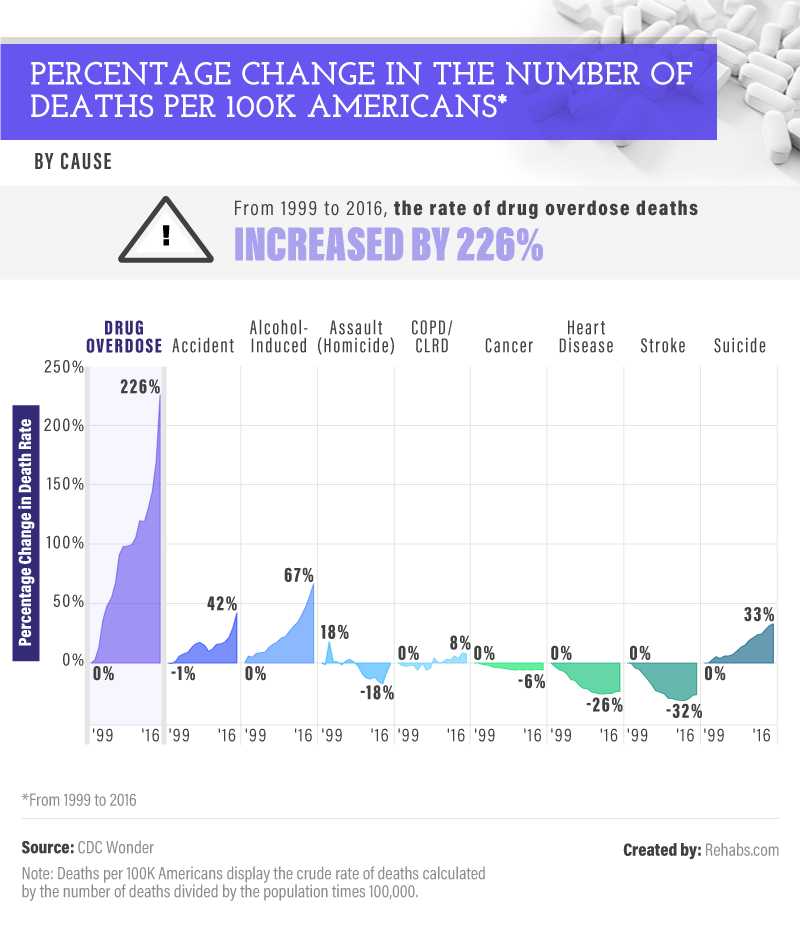
Drug-related fatalities in America may still account for a lower rate of death than more natural causes like cancer, chronic obstructive pulmonary disease (COPD), stroke, or other diseases, but what’s more relevant to the evolving crisis isn’t so much the cumulative figure as it is the percentage increase over the last 18 years.
Among diseases, deaths caused by cancer (-6 percent), heart disease (-26 percent), and stroke (-32 percent) all decreased in America between 1999 and 2016. Other conditions commonly attributed to death across the U.S. like suicide (+33 percent) and accidents (+42 percent) increased substantially over that same time frame. But, no cause of death rose as rapidly as drug and alcohol abuse.
While a certain level of alcohol consumption can be safe, the harsh reality is that 7 percent of Americans suffer from an alcohol use disorder, and between 1999 and 2016, the number of fatalities associated with alcohol increased by 67 percent.
If you think that figure seems high, it’s nothing compared to the percentage increase in drug overdoses. Between 1999 and 2016, the rate of fatalities stemming from drug abuse and addiction increased by 226 percent.
Affliction by Age
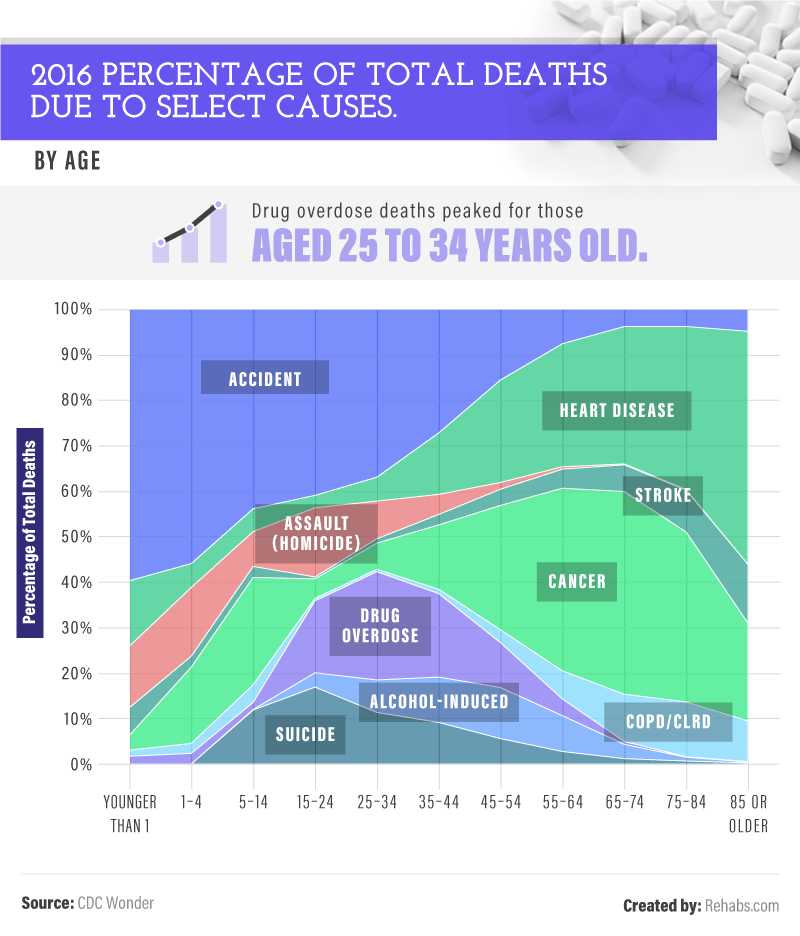
This graph illustrates the ages at which certain causes of death are more prevalent.
In some ways, these trends may represent a natural correlation in life. Diseases like cancer, COPD, heart disease, and stroke were the most common among Americans in their late-50s and older, while accident-related deaths were more common among children and teens. Even though alcohol-induced fatalities peaked along a threshold of age ranges (from 15 to 74), drug overdoses had a very specific and more contained area of impact.
In 2016, the rate of mortality for people between the ages of 25 and 34 was 129 per 100,000 people. According to the Centers for Disease Control and Prevention (CDC), the number of fatalities among young adults hasn’t been that high since the HIV/AIDS crisis in the ’80s. Perhaps even more alarming, deaths among people in this age group continue to rise at a staggering rate. Just between 2014 and 2016, drug-related overdoses increased by 19 percent in the 25- to 36-year-old demographic. A vast majority of this rise is attributable to opiate overdoses, particularly those involving heroin, non-heroin opiates, and synthetic prescription opioids including fentanyl.
Drug Abuse by the Numbers
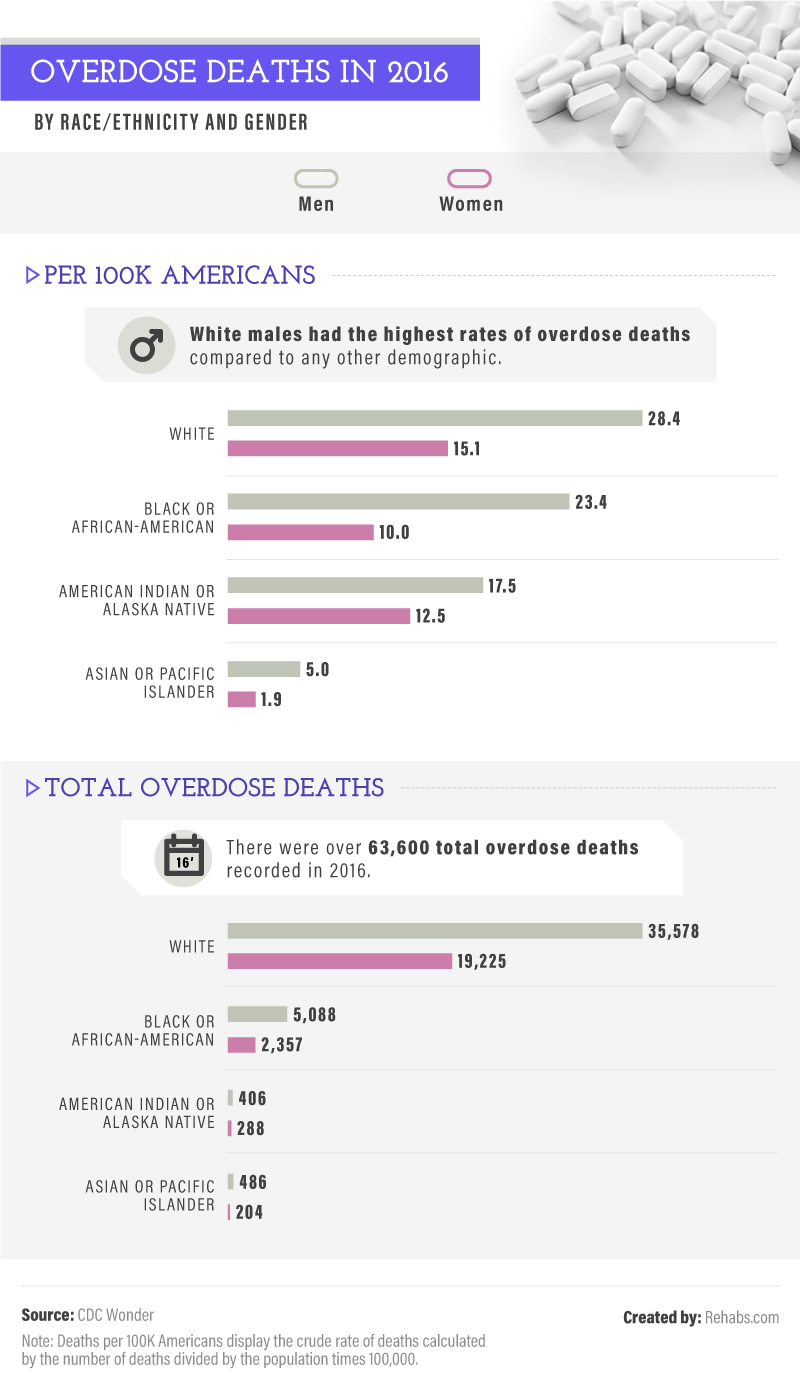
When addiction is involved, recovery can feel like an impossible battle. The substances most commonly associated with overdose fatalities (including opiates and alcohol) are also among those with the worst withdrawal symptoms of any narcotics. In some cases, the substances are so powerful that the body struggles during the natural cleansing process and may require a medical detox program to help impacted individuals overcome the hold of addiction.
With certain substances, there are a number of ways that overdoses can occur. A person may take too much of a prescribed medication, they may deliberately take an increased amount to achieve a certain feeling or effect, or they may experience a complicated reaction between the drug and other substances or medications. In 2016, white men in America represented more than half of all overdose deaths, followed by white women who accounted for nearly 1 in 3 overdose fatalities. Overwhelmingly, across all demographics, drug overdoses were more likely to impact men than women. Among American Indians, Asian or Pacific Islanders, and African-Americans, men accounted for roughly double the total overdoses of women in their same demographics.
Growing Concerns
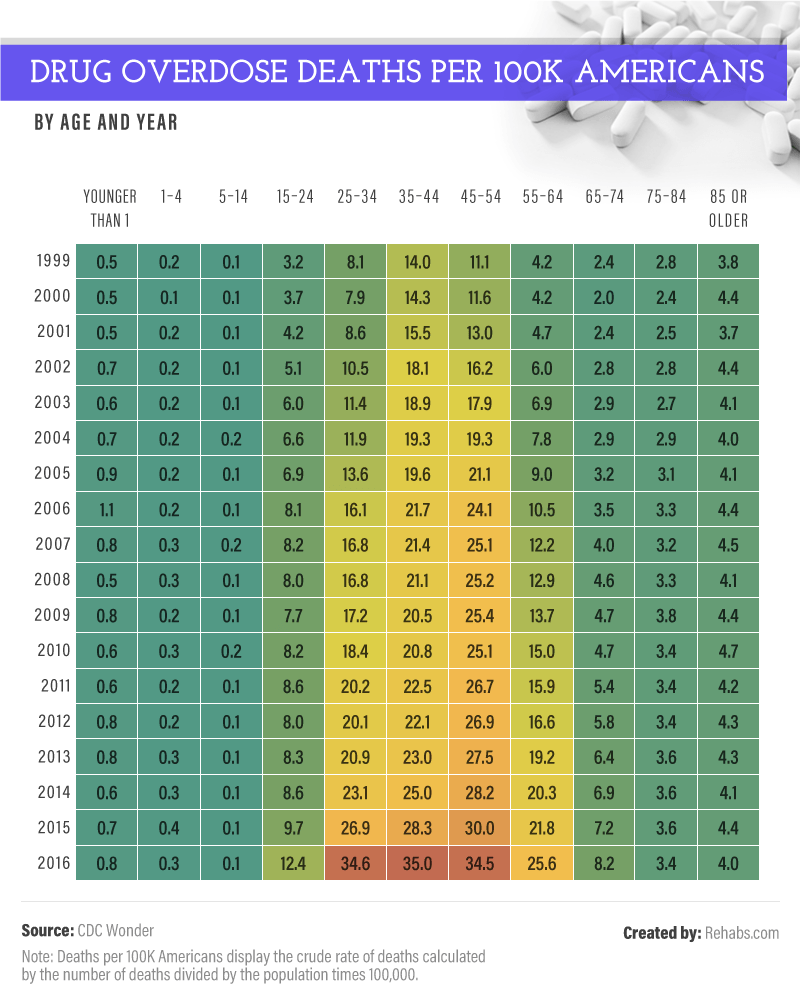
The drug epidemic in America today represents the deadliest epidemic in this country’s history. While the number of lives lost to prescription drugs and opiates continues to climb, there remains no clear consensus on how to combat this emergency. Politicians disagree on how to spend national funding, communities disagree on how to approach addiction treatment, and even health experts sometimes clash over the best course for battling addiction.
Ultimately, there are two major problems at hand: the overwhelming number of people in America already addicted to opioids who struggle to get clean, and the future generations of people who could begin misusing or abusing opioids at any given time.
While policymakers and health advocates continue to fight for ways to reduce the spread of addiction, drug overdoses are growing at a startling rate. People between the ages of 25 and 44 have been particularly affected, with the rate of drug overdoses rising to almost 35 deaths per 100,000 people. While other age groups are not immune to the impact of the drug crisis, none are as affected as young Americans whose death rates only continue to climb.
Mortality Trends
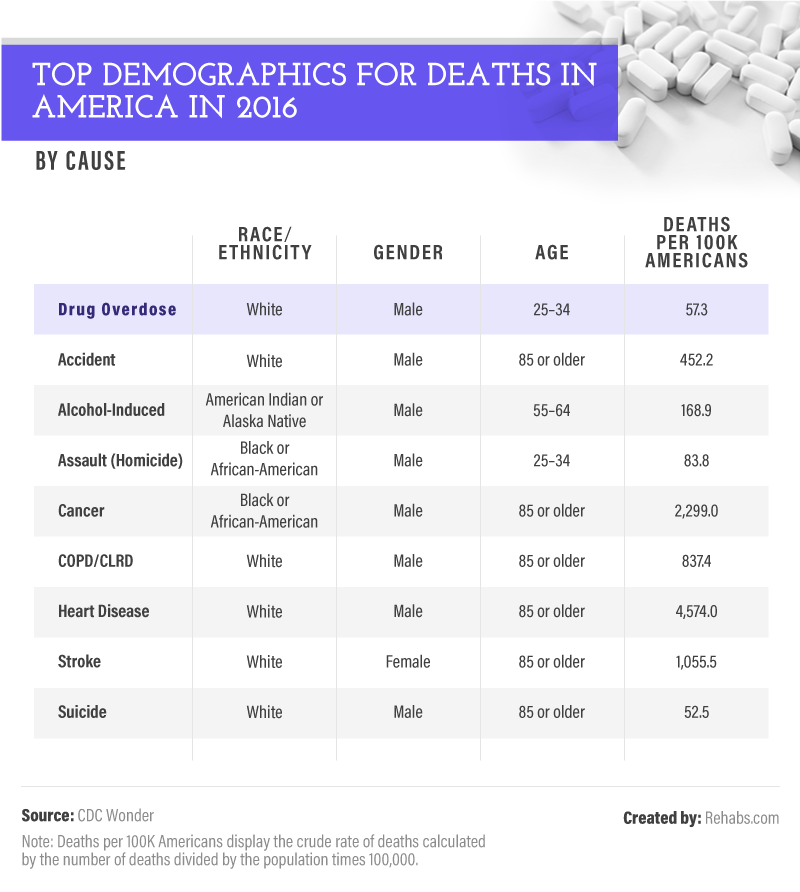
Here you can explore which demographics are most at risk for exposure and death by various causes. White men between the ages of 25 and 34 made up the majority of overdose deaths, and American Indians between the ages of 55 and 64 were more at risk for alcohol-induced fatalities. Unlike overdoses, where just over 57 white men out of 100,000 died from drug abuse, nearly 169 American Indians out of 100,000 between the ages of 55 and 64 died in 2016 from alcohol consumption.
Cancer was more common among African-American men aged 85 or older, and white women were the most susceptible to just one cause of death over men: strokes. For women, high blood pressure, contraceptives, and pregnancy are among the leading causes of strokes, in addition to atrial fibrillation and depression.
Crisis in Retrospect
The drug crisis in America isn’t new. By some standards, the opioid epidemic has been building for the last 150 years. What’s undeniable is that the dangers of drug use across the U.S. have risen to new heights, and every year the death toll associated with these overdoses continues to climb. While other causes of death in America have declined since 1999, drug-related fatalities have increased by over 200 percent. And not all demographics are affected equally by this disease: more than any other group, young white men seem to make up the bulk of those most impacted by drug overdoses and death.
If you or someone you love is battling addiction, it’s important to know that help is here for you, and you are not alone. At Rehabs.com, we approach every client as a whole and unique person and work hard to help you find the best drug and alcohol care available. Our accredited facilities, research-based therapy, and aftercare planning mean you’ll have a guide through every phase of recovery. Addiction is a chronic and treatable disease, and we’re here to help you heal and take back your life. To learn more, visit us at Rehabs.com.
Methodology
International cause of death codes were defined by the CDC Underlying Cause-of-Death Lists for Tabulating Mortality Statistics, Part 9:
- Chronic Lower Respiratory Diseases (J40-J47)
- Diseases of the Heart (I00-I09, I11, I13, I20-I51)
- Cerebrovascular Diseases (I60-I69)
- Accidents (Unintentional Injuries) (V01-X59, Y85-Y86)
- Assault (Homicide) (U01-U02, X85-Y09, Y87.1)
- Suicide (U3, X60-X84, Y87.0)
- Malignant Neoplasms (C00-C97)
- Alcohol-Induced
Data were queried from the CDC Wonder Multiple Cause of Death database on Aug. 13, 2018. The causes of death selected include the top five causes of death overall including diseases of the heart, malignant neoplasms, cerebrovascular disease, chronic lower respiratory disease (COPD), and accidents. Drug overdose, assault, suicide, and alcohol-induced deaths were selected for comparative purposes. Overdose-related deaths included both overdoses as a result of intentional suicide and/or homicide. Accidents or unintentional injuries include accidental overdoses.
Data representing 9 or fewer deaths or births are suppressed for privacy purposes. It is possible that changes to cause of death classifications by the CDC could affect historical trends.
If you’re struggling with substance misuse or addiction, or you know someone who is, please contact American Addiction Centers at to learn more about addiction treatment options. You can also look at some of the facilities listed below to see if they provide the program you are looking for:
- California: Laguna Treatment Center
- Florida: Recovery First Treatment Center
- Florida: River Oaks Treatment Center
- Nevada: Desert Hope Treatment Center
- Mississippi: Oxford Treatment Center
- Texas: Greenhouse Treatment Center
Fair Use Statement
The conversation about drug addiction in America is ongoing. Help us spread the word by sharing the results of this study with your readers for any non-commercial use. We only ask that you ensure a link back to this page so that our contributors earn credit for their work too.